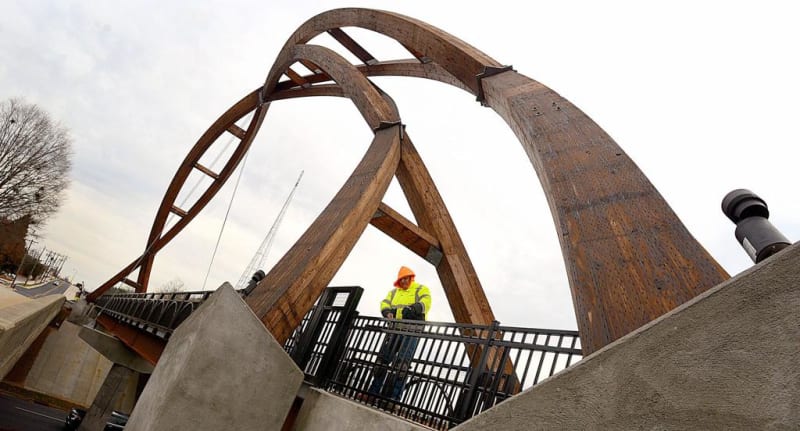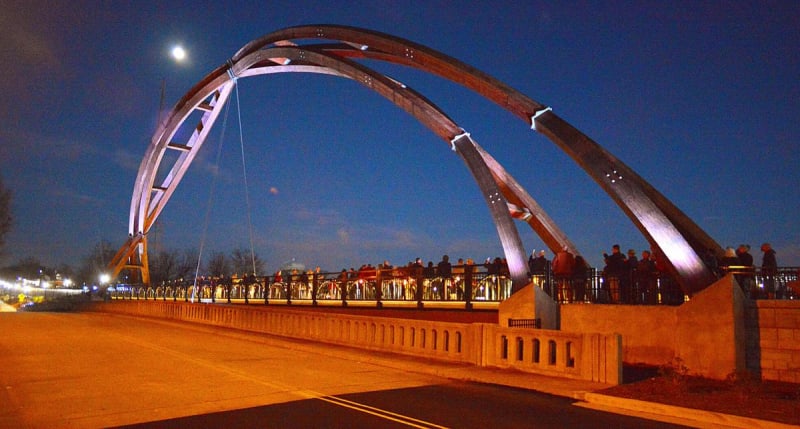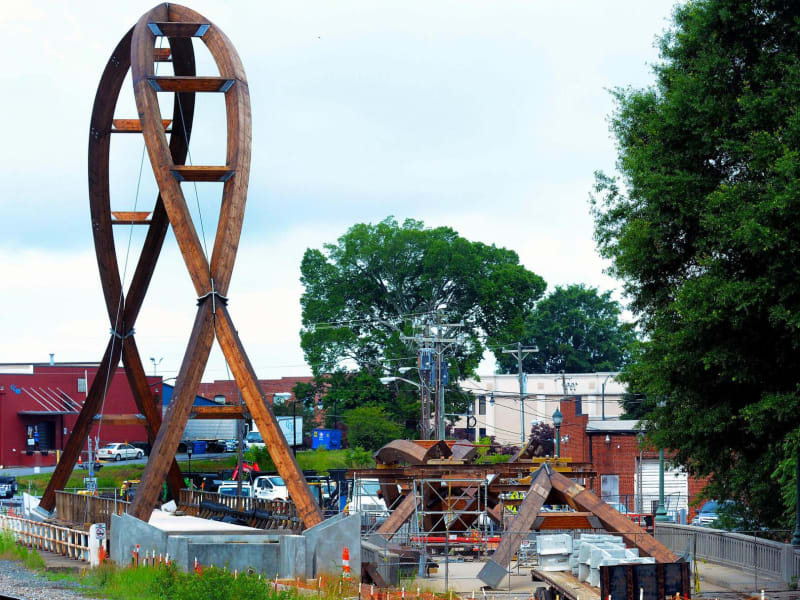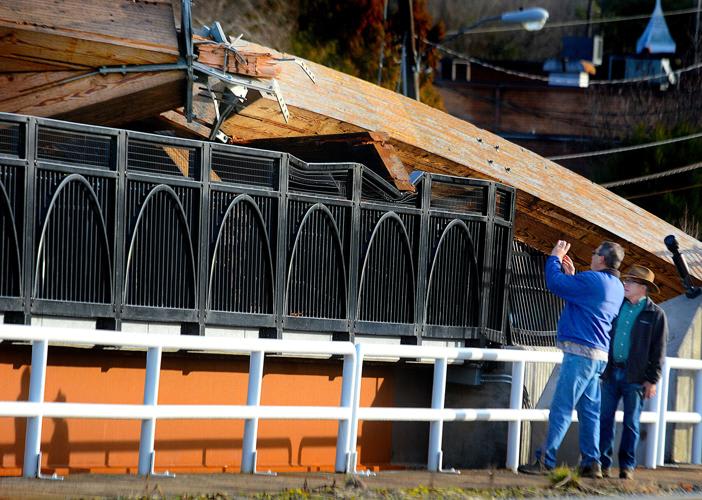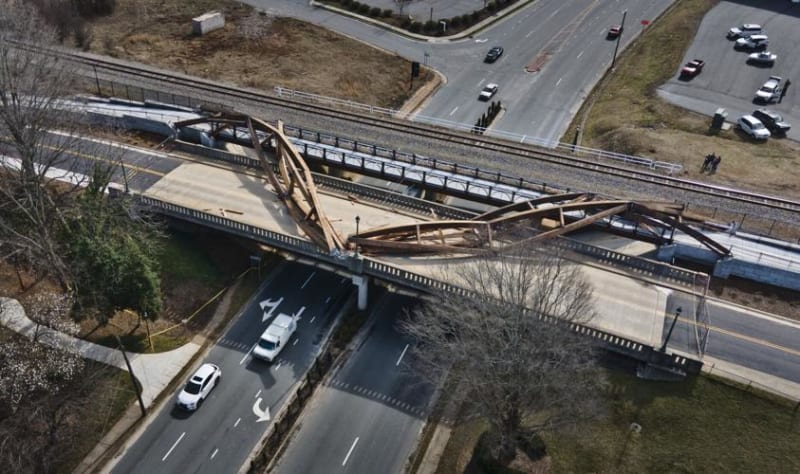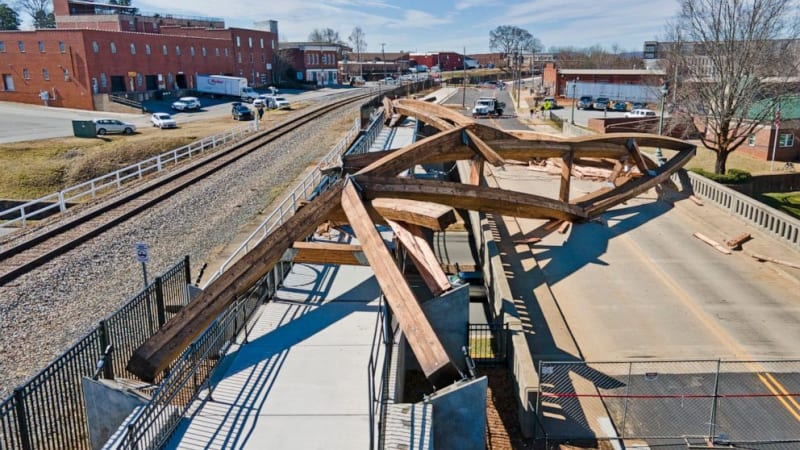Navigation
Install the app
How to install the app on iOS
Follow along with the video below to see how to install our site as a web app on your home screen.
Note: This feature may not be available in some browsers.
More options
Style variation
-
Congratulations cowski on being selected by the Eng-Tips community for having the most helpful posts in the forums last week. Way to Go!
You are using an out of date browser. It may not display this or other websites correctly.
You should upgrade or use an alternative browser.
You should upgrade or use an alternative browser.
40-ton timber arches collapse in Hickory, NC 35
- Thread starter bugbus
- Start date
- Status
- Not open for further replies.
Alistair_Heaton
Mechanical
Can someone provide details of the fix last year?
The link is blocked to the eu
The link is blocked to the eu
Look the least bit familiar?:
[URL unfurl="true"]https://res.cloudinary.com/engineering-com/image/upload/v1645563680/tips/Screen_Shot_2022-02-22_at_12.54.55_PM_v3xa2k.tiff[/url]
Skyline Ranch Road, Bend OR, by Western Wood Products
spsalso
[URL unfurl="true"]https://res.cloudinary.com/engineering-com/image/upload/v1645563680/tips/Screen_Shot_2022-02-22_at_12.54.55_PM_v3xa2k.tiff[/url]
Skyline Ranch Road, Bend OR, by Western Wood Products
spsalso
-
1
- #84
Electronbelt
Industrial
If you look at Western Wood Structures portfolio ( [URL unfurl="true"]https://www.westernwoodstructures.com[/url] ) as well as some of their YouTube videos, they use this type of pin connection quite a bit, through this arch uses the 'lightest' example of it that I have seen. I suspect it is used in dealing with the expansion/contraction of their structures.
None the less, Western Wood Structures is pretty clearly not a run-of-the-mill 'design' firm as they have some simply phenomenal structures across the world (some of which I've seen in person) - which makes this arch creation (and failure) all the more baffling.
None the less, Western Wood Structures is pretty clearly not a run-of-the-mill 'design' firm as they have some simply phenomenal structures across the world (some of which I've seen in person) - which makes this arch creation (and failure) all the more baffling.
Look the least bit familiar?:
That bridge's arches are structural and required to keep the walkway in place
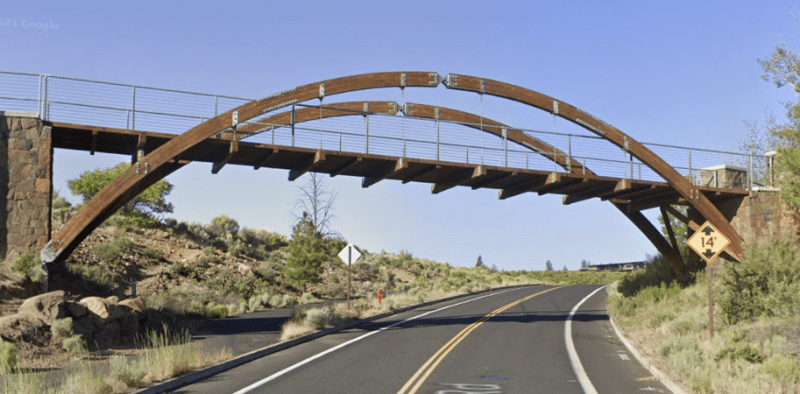
TTFN (ta ta for now)
I can do absolutely anything. I'm an expert! faq731-376 forum1529 Entire Forum list
-
3
- #86
Good find. At 7:03 in the video, it certainly looks like the structure folded over on the lower hinge points.
TTFN (ta ta for now)
I can do absolutely anything. I'm an expert! faq731-376 forum1529 Entire Forum list
TTFN (ta ta for now)
I can do absolutely anything. I'm an expert! faq731-376 forum1529 Entire Forum list
Brian Malone
Industrial
Hickory Record story concerning the work stoppage prior to raising the second arch.
Electronbelt
Industrial
It is hard for me to tell with the grainy security camera footage (seems to be a staple here at eng-tips...), but it sure looks to me like the tip started to fail first and then overloaded the lower fixed "hinge" points causing them to fail and twist as it rolled over.
I cannot imagine it would take much horizontal load on that single pin joint at the top to cause it to tear out as it appears in gusmurr's earlier post.
I cannot imagine it would take much horizontal load on that single pin joint at the top to cause it to tear out as it appears in gusmurr's earlier post.
Red Corona
Computer
Those cables definitely look decorative, with the way they're attached and the angle. I guess they were just tensioned enough to look good. So what was supposed to be stopping it from blowing over?
As soon as that failed and it started going, it would have put the windward side cable under massive tension and it would have pinged, which looks like what happened in the pics where you can see the broken cable. But that's a symptom not a cause imo. Looks like those crossover joints half way up just weren't up to the job.
EDIT: posted this before seeing the vid. It looks like this halfway up hinge failed on one side, that side then dragged the other half down and that would have pulled the cable as well.
As soon as that failed and it started going, it would have put the windward side cable under massive tension and it would have pinged, which looks like what happened in the pics where you can see the broken cable. But that's a symptom not a cause imo. Looks like those crossover joints half way up just weren't up to the job.
EDIT: posted this before seeing the vid. It looks like this halfway up hinge failed on one side, that side then dragged the other half down and that would have pulled the cable as well.
dik (Structural) 22 Feb 22 16:20 said:The gif is neat, but did anyone notice that degree of motion?
Thanks for the neat comment but I think you missed the point. The gifs only purpose was to convey the idea of the freedom of movement, full stop. What might be obvious (and may not) is that once any movement starts, other factors quickly come into play and complicate the collapse sequence. I for one am not ready to meld half a dozen or more factors into one animation, let alone fine tune it to inches or less. The gif was neat but it's also wrong (I fear) and not because it moves south instead of north or moves to far. Much to my dismay, I finally took a closer look at the math of the guy wire and realized I was out to lunch, or should have just had lunch instead. In order for that gif motion to occur, something else had to break first (the guy wire or another connection).
TugboatEng (Marine/Ocean) 22 Feb 22 07:27 said:... perforated metal strips must have been the repair as they're not visible in other images ...
Thanks for posting, I was looking for images relating to the repair or where the crew may have been working at the time but had not found any. That flimsy repair may be the key. A closer analysis of the videos just posted may reveal that leg buckling first.
I believe it's the connector of the lower arch on the east end of the structure. In the closeup, the timber to the right of the connector is of the upper arch. Only a fragment of the lower wishbone remains. That southeast leg fell off and under the bridge.

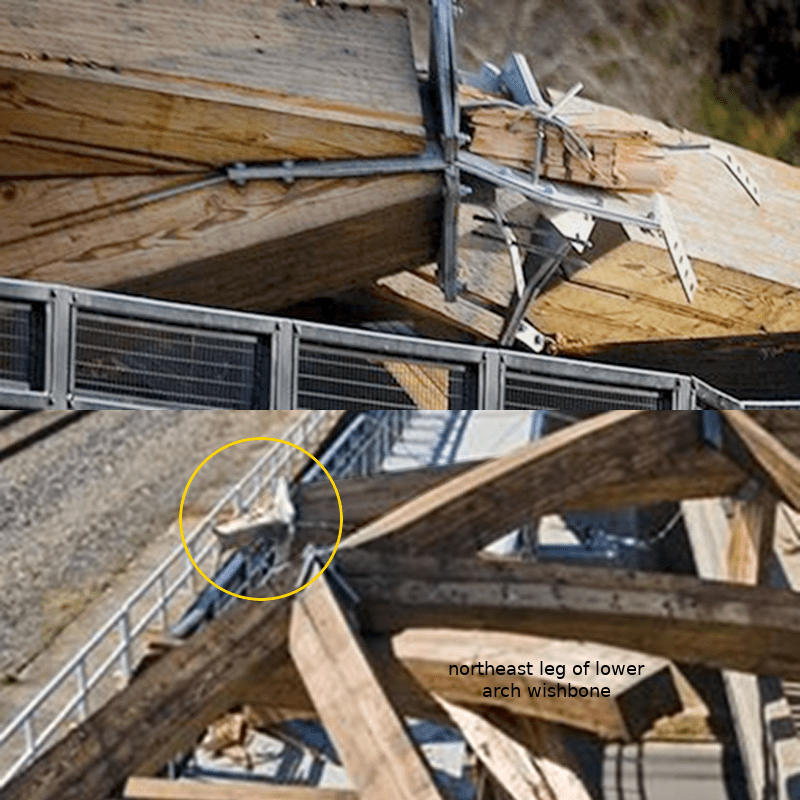
Red Corona said:Looks like those crossover joints half way up just weren't up to the job.
Seems like it. They needed to be rigid to prevent 5 hinged arch formation, and also to prevent it falling over laterally like it ended up doing.
The gif may have obscurred or detracted from the failure. Movement would be nowhere near that magnitude, and people seeing the clip might be expecting that type of failure.
Failure did not appear to be from a cyclical loading. From the clip posted by Hokie, it appears that there was no movement due to wind and that the one cable may have failed, allowing the top of the arch to fall to the right, bringing down the 'fixed' base parts. All is speculation; it's a matter of 'those in the know' posting the real cause of the collapse.
It would be nice to see the failure parts to see how the components fared... I suspect strongly that the one cable 'snapped' for whatever reason. Cable failure may have precipitated the collapse, or some component/connection failed causing the overload to the cable. I suspect that the one cable is 'broken', but I don't know for sure.
Rather than think climate change and the corona virus as science, think of it as the wrath of God. Feel any better?
-Dik
dik said:Movement would be nowhere near that magnitude, and people seeing the clip might be expecting that type of failure.
The failure looked pretty much like that from the first video. Isn't that all the gif was saying likely happened? That the top fell over? I didn't think he was saying it looked like that in service. Merely that it looked like that when falling over.
The wind was blowing in the video. Flags near horizontal. So likely it blew over in the end.
-
1
- #97
Direct Links to videos:
[URL unfurl="true"]https://whky.com/wp-content/uploads/2022/02/2022-02-18-13-06-39-2.mov[/url]
[URL unfurl="true"]https://whky.com/wp-content/uploads/2022/02/FPS-arch-video.mov[/url]
[URL unfurl="true"]https://whky.com/video-footage-of-collapse-of-arches-shared-by-city-of-hickory/[/url] (click on the video icon near the bottom of the story for a third video)
[URL unfurl="true"]https://whky.com/wp-content/uploads/2022/02/2022-02-18-13-06-39-2.mov[/url]
[URL unfurl="true"]https://whky.com/wp-content/uploads/2022/02/FPS-arch-video.mov[/url]
[URL unfurl="true"]https://whky.com/video-footage-of-collapse-of-arches-shared-by-city-of-hickory/[/url] (click on the video icon near the bottom of the story for a third video)
I just discovered that the location of the elevated hinges may have contributed to the collapse. Take a gander at the sketch. By elevating the hinges, the extension to the cable can be minimised so it offers little lateral resistance. That may be the cause.
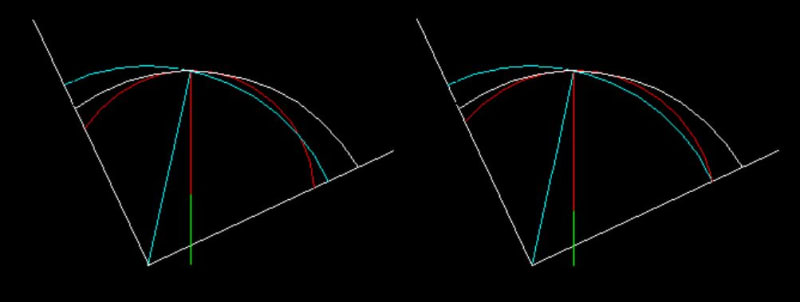
The blue is the trajectory of the cable and the red is the trajectory of the crown of the arch from the elevated 'base'. The white is the trajectory of the crown of the arch if the rotation were about a non-elevated base. The difference in the two schemes is the location of the elevated base.
Rather than think climate change and the corona virus as science, think of it as the wrath of God. Feel any better?
-Dik

The blue is the trajectory of the cable and the red is the trajectory of the crown of the arch from the elevated 'base'. The white is the trajectory of the crown of the arch if the rotation were about a non-elevated base. The difference in the two schemes is the location of the elevated base.
Rather than think climate change and the corona virus as science, think of it as the wrath of God. Feel any better?
-Dik
yes, the red thing and the red trajectory... nearly matches the blue cable trajectory. The white shows the extension to the cable required if the base of the arch were at the bottom, and not elevated to the point at the intersection of the green and red vertical line. The cable may not even be broken. I'm just trying to show that the cables may have been totally ineffective, or seriously compromised. the white lines starting from the base of the cable are 'trim' lines only for cutting the circle circumference. ![[pipe] [pipe] [pipe]](/data/assets/smilies/pipe.gif)
I just realised that in the Right Sketch, the cable is in tension. In the Left Sketch the cable ismostly partially in compression and the first rule of engineering is that you can't push on a rope... maybe we've solved the manner of collapse.
Rather than think climate change and the corona virus as science, think of it as the wrath of God. Feel any better?
-Dik
![[pipe] [pipe] [pipe]](/data/assets/smilies/pipe.gif)
I just realised that in the Right Sketch, the cable is in tension. In the Left Sketch the cable is
Rather than think climate change and the corona virus as science, think of it as the wrath of God. Feel any better?
-Dik
- Status
- Not open for further replies.
Similar threads
- Replies
- 35
- Views
- 13K
- Replies
- 13
- Views
- 13K
- Replies
- 8
- Views
- 6K
- Replies
- 1
- Views
- 648
- Replies
- 46
- Views
- 7K

